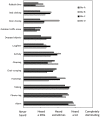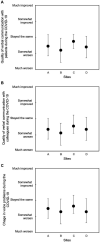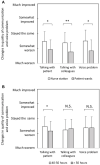Prevalence of voice handicap among nurses in intensive care units due to occupational noise during pandemic
- PMID: 37727611
- PMCID: PMC10505665
- DOI: 10.3389/fpubh.2023.1250512
Prevalence of voice handicap among nurses in intensive care units due to occupational noise during pandemic
Abstract
Background: Healthcare workers have been identified as being at risk of occupational voice disorders. Among them, nurses working in intensive care units (ICUs) are particularly vulnerable due to the risk factors that are associated with their exposure to high levels of noise. Thus, this study aimed to determine the prevalence of voice disorders among ICU nurses.
Methods: A questionnaire was administered to 100 ICU nurses from four hospitals in China. The questionnaire assessed vocal-related symptoms, perceived voice handicap, frequently heard noise sources, and the quality of communications.
Results: Results indicate that the most frequently reported voice symptoms were 'voice tiredness' and 'voiceless'. Nurses working more than 50 h per week experienced voice symptoms more frequently than nurses working for 40-50 h per week. The median value of the perceived voice handicap score (VHI-30) was 23, indicating mild voice handicap, while 24% of the nurses reported severe voice handicap. Longer working hours and working at patient wards were significantly associated with higher VHI-30 scores. The nurses also reported that the quality of verbal communication with patients and colleagues and voice problems worsened during the COVID-19 pandemic.
Conclusion: More than 20% of nurses reported severe voice handicap, however, voice handicap among ICU nurses did not appear universally to all nurses. Further research is necessary to identify the risk factors associated with voice disorders and the mechanism behind such heterogeneity among ICU nurses.
Keywords: communication; intensive care unit; nurses; occupational health; pandemic (COVID-19); voice handicap; voice handicap index.
Copyright © 2023 Song, Lee and Jung.
Conflict of interest statement
The authors declare that the research was conducted in the absence of any commercial or financial relationships that could be construed as a potential conflict of interest.
Figures



Similar articles
-
Voice use of nurses working in the intensive care unit during the COVID-19 pandemic.Intensive Crit Care Nurs. 2024 Jun;82:103620. doi: 10.1016/j.iccn.2023.103620. Epub 2024 Jan 16. Intensive Crit Care Nurs. 2024. PMID: 38232571
-
Prevalence of Voice Disorders in Healthcare Workers in the Universal Masking COVID-19 Era.Laryngoscope. 2021 Apr;131(4):E1227-E1233. doi: 10.1002/lary.29172. Epub 2020 Oct 12. Laryngoscope. 2021. PMID: 33009672 Free PMC article.
-
The Impact of Masking Habits on Voice in a Sub-population of Healthcare Workers.J Voice. 2024 Jul;38(4):918-921. doi: 10.1016/j.jvoice.2021.11.002. Epub 2022 Jan 2. J Voice. 2024. PMID: 34986996 Free PMC article.
-
A cross sectional study on the vocal handicap index applied to a sample of teachers in nurseries and primary school.Ann Ig. 2019 May-Jun;31(3):230-235. doi: 10.7416/ai.2019.2285. Ann Ig. 2019. PMID: 31069367
-
Influence of the characteristics of home office work on self-perceived vocal fatigue during the COVID-19 pandemic.Logoped Phoniatr Vocol. 2022 Dec;47(4):279-283. doi: 10.1080/14015439.2021.1961310. Epub 2021 Aug 11. Logoped Phoniatr Vocol. 2022. PMID: 34379044
Cited by
-
Investigation of the voice handicaps in Parkinson's disease and determination of the clinical correlates.J Neural Transm (Vienna). 2025 Jun;132(6):859-866. doi: 10.1007/s00702-025-02910-6. Epub 2025 Mar 24. J Neural Transm (Vienna). 2025. PMID: 40128404
-
Noise and sound in the intensive care unit: a cohort study.Sci Rep. 2025 Mar 29;15(1):10858. doi: 10.1038/s41598-025-94365-8. Sci Rep. 2025. PMID: 40157982 Free PMC article.
References
MeSH terms
LinkOut - more resources
Full Text Sources
Medical

